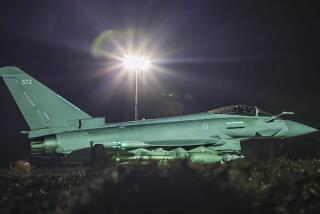U.S. drone attack kills 25 in Pakistan
Reporting from — A U.S. missile strike killed at least 25 people Friday in Pakistan’s North Waziristan region, signaling that Washington’s use of drones against militants along the Afghan border will continue despite intensifying opposition from Pakistani leaders.
The strike in the village of Spinwam came just two days after Adm. Michael G. Mullen, chairman of the U.S. Joint Chiefs of Staff, held tense talks with Pakistani army chief Gen. Ashfaq Kayani amid a pall of mistrust that has weakened relations between Washington and Islamabad in recent months.
After their session here Wednesday, Kayani repeated Pakistan’s opposition to the use of drones, saying the strikes “not only undermine our national effort against terrorism but turn public support against our efforts.”
Pakistan intensified its criticism of the drone campaign after a March 17 strike killed more than 40 people in the North Waziristan village of Datta Khel. Pakistani military leaders said that missile strike killed civilian tribal elders meeting to discuss a dispute over local mining rights, though the U.S. maintains that the people killed were militants.
The Datta Khel strike came just a day after the release of Raymond Davis, the CIA contractor whose arrest in connection with the shooting deaths of two Pakistanis brought relations between Washington and Islamabad to one of their lowest points in years.
Officials in North Waziristan said Friday’s strike killed 18 suspected militants, along with three women and four children. Four missiles were fired, two of which struck a guesthouse containing the suspected militants, said the officials, who requested anonymity because they were not authorized to speak with journalists. The other two missiles hit a building in the compound where the women and children were.
The strike, coming just two days after Kayani’s denunciation of the drone campaign, paralleled the sequence of events earlier this month, when the head of Pakistan’s spy agency met with his CIA counterpart, Leon E. Panetta, in Washington and called for a sharp reduction in drone strikes. The U.S. gave no indication to Lt. Gen. Ahmed Shuja Pasha of the Inter-Services Intelligence directorate, or ISI, that it would relent, and instead launched a drone strike two days later in South Waziristan that killed six suspected militants.
Washington views drone strikes as one of its most effective tactics against Al Qaeda and Taliban militants in Pakistan’s largely ungoverned tribal badlands along the Afghan border. Since the start of 2010, most of those strikes have been concentrated on North Waziristan, the only tribal district where the Pakistani army has yet to launch a major military operation.
The Haqqani network, an Afghan Taliban wing responsible for many of the attacks on U.S., NATO and Afghan security forces in eastern Afghanistan, uses North Waziristan as a base from which to reconnoiter and plan new operations.
Pakistan’s intelligence community has strong ties with the Haqqani network that date to the era when some of the militant group’s leaders fought the Soviet occupation of Afghanistan with the support of the U.S. Washington has repeatedly accused the ISI of continuing to nurture those ties, an assertion Mullen bluntly raised this week during interviews with several Pakistani news organizations during his visit to Islamabad, the capital.
“The ISI has a long-standing relationship with the Haqqani network; that doesn’t mean everybody in the ISI, but it’s there,” Mullen told the Geo television network. “I believe over time that has got to change.”
Kayani responded tersely, saying he “rejected negative propaganda of Pakistan not doing enough” to battle militants in the volatile northwest.
For months, Pakistani military leaders have been saying they will eventually launch an operation against militants in North Waziristan, but only when they feel the time is right and not as a result of pressure from Washington. They say they cannot carry out such an offensive now because their manpower is already overstretched: Pakistani troops remain deployed in South Waziristan and other tribal areas where they are needed to keep the Taliban from reestablishing strongholds, or where fighting with militants continues.
Analysts, however, say the army cannot indefinitely put off taking on militants in North Waziristan in some fashion, largely because the homegrown Pakistani Taliban also uses the region as a haven and as a training ground for suicide bombers who target mosques, shrines, markets and security installations in Pakistan.
“These safe havens are the greatest danger to Pakistan itself,” said security analyst Talat Masood, a retired Pakistani army general. “There are serious problems when you go for full-fledged attack in North Waziristan. It could unite various militant groups there that are not united now.... But that doesn’t mean that North Waziristan can be left the way it is for all time.”
Special correspondent Zulfiqar Ali in Peshawar, Pakistan, contributed to this report.
More to Read
Sign up for Essential California
The most important California stories and recommendations in your inbox every morning.
You may occasionally receive promotional content from the Los Angeles Times.










